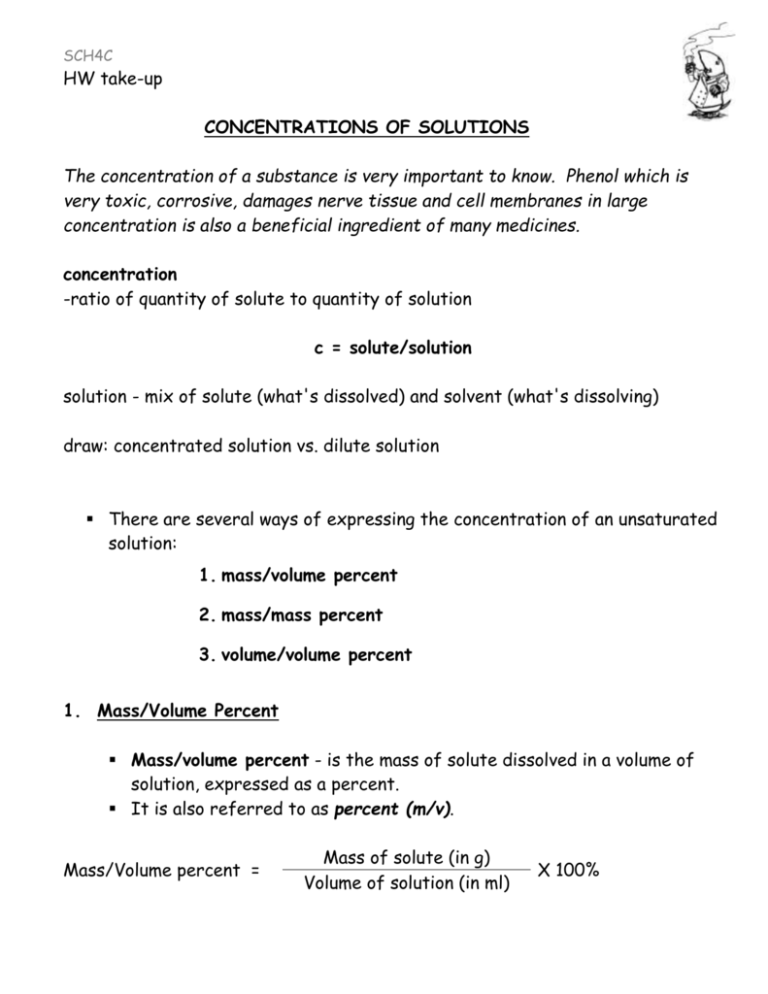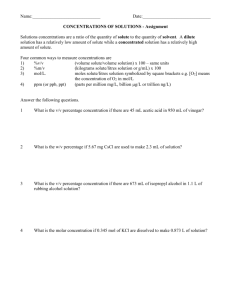THE MOLE AND MOLAR MASS - ahsbogna
advertisement

SCH4C HW take-up CONCENTRATIONS OF SOLUTIONS The concentration of a substance is very important to know. Phenol which is very toxic, corrosive, damages nerve tissue and cell membranes in large concentration is also a beneficial ingredient of many medicines. concentration -ratio of quantity of solute to quantity of solution c = solute/solution solution - mix of solute (what's dissolved) and solvent (what's dissolving) draw: concentrated solution vs. dilute solution There are several ways of expressing the concentration of an unsaturated solution: 1. mass/volume percent 2. mass/mass percent 3. volume/volume percent 1. Mass/Volume Percent Mass/volume percent - is the mass of solute dissolved in a volume of solution, expressed as a percent. It is also referred to as percent (m/v). Mass/Volume percent = Mass of solute (in g) Volume of solution (in ml) X 100% SCH4C example: A solution of hydrochloric acid was formed by dissolving 1.52 g of hydrogen chloride gas in enough water to make 24.1 ml of solution. What is the concentration in percent (m/v) of the solution? 2. Mass/Mass Percent Mass/mass percent-is the mass of solute dissolved in a given mass of solution, expressed as a percent. It is also referred to as percent (m/m) or mass percent It is often inaccurately referred to as the weight (w/w) percent. Mass of solute (in g) Mass/Mass percent = X 100% Mass of solution (in g) example: If 55 g of potassium hydroxide is dissolved in 100 g of water, what is the concentration of the solution expressed as mass/mass percent? 3. Volume/Volume Percent When mixing two liquids to form a solution it is easier to measure their volumes rather than their mass. Volume/volume percent-is the volume of solute in a given volume of solvent, expressed as a percent. It is also referred to as volume percent concentration, volume percent, percent (v/v), or percent by volume. Volume/Volume percent = Volume of solute (in ml) Volume of solution (in ml) X 100% ex. 30 mL of sulphuric acid was added to 220 mL of dH20, what's the % c, V/V --> both units for solute and solution need to be in either mL or L, ex. 2mL/30mL or 0.002 L / 0.03 L NOT 2 mL/ 30 L SCH4C MOLAR CONCENTRATION -amount of solute, in moles, that is dissolved in one litre of solution molar concentration = moles solute (mol) /volume solution (L) - units : mol/L ex1. a sodium hydroxide solution contains 0.564 mol sodium hydroxide in 350 mL solution. Calculate the molar concentration of the sodium hydroxide solution. mol NaOH = 0.564 mol volume solution = 350 x 1L/1000 mlL ex2. 23.4 g of copper II sulfate (CuSO4) is dissoved in water to make 200 mL sol'n. Calculate the molar concentration of copper II sulfate solution. STEPS 1. what do you need? moles of CuSO4 convert 23.4 g CuSO4 to moles (you know how!) 2. calculate concentration (in mol/L) ex3. a sample of ammonia solution has a concentration of 0.2 mol/L. What mass of ammonia is present in a 3 L bottle? STEPS 1. use the concentration to figure out the number of moles of ammonia, NH3 0.2 mol/L x 3 L = ___ mol ammonia --> note: L cancels out, mol stays 2. convert number of moles to mass in grams (you know how!) SCH4C PARTS PER MILLION (ppm) - in environmental studies very dilute solutions need to be analyzed, ex. dioxin: 3 x 10-6 mol/L (a toxic pollutant produced by paper industry) - for very dilute solutions we use ppm or ppb or ppt - for ppm, in general this corresponds to 1 g of chlorine in 1000L of pool water or 1 mg per L (1 drop in a bathtub) 1 g = 1000 mg look p.283 for MAC’s Chemical Contaminants of Drinking Water - recall: water is a polar molecule, a “universal solvent” that sticks together and attracts other water molecules to it - chemical contaminants are substances that are soluble in water: manufactured chemicals, metal ions, pesticides, fertilizers, petroleum products - nature can absorb/neutralize some of this but not all, ex. DDT pesticides, PCB’c, heavy metals etc. p.282 for sources and effects ex 1. In a chemical analysis, 3.5 mg of oxygen were measured in 350 mL of sea water. What is the concentration of oxygen, in ppm? ex 2. The maximum permitted mass of Pb in 1.0 L of drinking water is 5.0 x 105 g. What is this concentration, in ppm? p.284 #3, 5 p. 288 – 289 #1,2,3 SCH4C Portfolio: CONCENTRATIONS OF SOLUTIONS On a separate piece of paper answer the following: 1. A pharmaceutical company is testing a new type of mouthwash. If the mouthwash contains 6.25 mL of ethanol per 250 mL, what is the V/V percentage concentration of ethanol? 2. Sabah puts 26 mL of milk into 310 mL of coffee. What is the V/V percentage concentration of milk in the new mixture? 3. A 5.0 L bottle of bleach contains approximately 0.60 g of sodium hypochlorite. Calculate the W/V percentage concentration of NaClO in bleach. 4. A skin cream that is designed to control acne contains 2.5% W/V salicylic acid, C7H6O3 (aq). What mass of salicylic acid is in a 192 mL bottle of skin cream? 5. A brine solution of hydrochloric acid is made by dissolbing 7.66 g of hydrogen chloride in enough water to produce 1.50 L of solution. Calculate the molar concentration of HCl in the solution. 6. Potassium dichromate, K2Cr2O7(aq), is used to analyze the alcohol content of wine. A lab technician dissolves 102.9 g os solid potassium dichromate in enough water to produce 1.75 L of solution. Determine the molar concentration of aqueous potassium dichromate in this solution.







